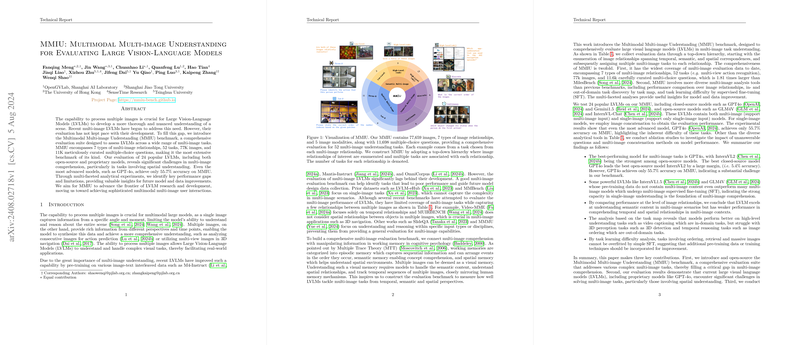An Expert Analysis of "MMIU: Multimodal Multi-image Understanding for Evaluating Large Vision-LLMs"
The ability to process and understand multiple images simultaneously is a significant challenge and an essential skill for Large Vision-LLMs (LVLMs). The paper "MMIU: Multimodal Multi-image Understanding for Evaluating Large Vision-LLMs" by Fanqing Meng et al. offers a robust solution to this challenge through the creation of the Multimodal Multi-image Understanding (MMIU) benchmark. MMIU provides a comprehensive evaluation suite designed to rigorously test LVLMs on a variety of multi-image tasks. This essay offers an expert overview of the paper, highlighting its key contributions, results, and potential implications for future research in the field.
Overview and Contributions
The primary contribution of MMIU is its extensive benchmark designed to evaluate the multi-image understanding capabilities of LVLMs. MMIU is uniquely comprehensive, encompassing:
- Diverse Evaluation Data: With 52 tasks covering 7 types of multi-image relationships, MMIU includes over 77,000 images and 11,698 meticulously curated multiple-choice questions. This breadth of data surpasses previous benchmarks such as LVLM-eHub and MileBench both in scale and task variety.
- Categorization and Hierarchy: The tasks are systematically categorized based on cognitive psychology principles into semantic, spatial, and temporal relationships. This classification allows for a nuanced evaluation across different dimensions of multi-image understanding, from low-level features like illumination to high-level features like object interactions and spatial reasoning.
- Comprehensive Analytical Tools: MMIU facilitates multi-faceted analyses, including performance comparisons over image relationships, task mapping to identify in- and out-of-domain tasks, and task learning difficulty assessment through supervised fine-tuning (SFT). These tools provide deeper insights into model capabilities and areas for improvement.
Key Findings and Results
Testing across 24 popular LVLMs, including both open-source and proprietary models, reveals several critical insights:
- Challenges in Multi-image Understanding: Even the most advanced model, GPT-4o, achieves only a 55.7% accuracy on MMIU, highlighting the intrinsic difficulty of multi-image tasks. This suggests that current LVLMs have significant room for improvement in multi-image comprehension, particularly in tasks involving spatial reasoning.
- Importance of Single-Image Understanding: Models with strong single-image understanding capabilities, such as InternVL1.5 and GLM4V, perform relatively well in multi-image tasks despite not being explicitly trained on multi-image data. This underscores the foundational importance of single-image comprehension as a stepping stone to multi-image understanding.
- Impact of Multi-image SFT: Models like Mantis and LLaVa-Interleave, which undergo extensive multi-image supervised fine-tuning, demonstrate substantive performance improvements over models trained predominantly on single-image data. This highlights the efficacy of targeted multi-image SFT.
- Performance Across Relationships: The models perform variably across different image relationships, excelling in semantic tasks but struggling with temporal and spatial relationships. This differentiation indicates specialized areas where future model training can be optimized.
Implications for Future Research
The introduction of MMIU has profound implications for both practical applications and theoretical advancements in AI:
- Benchmark-driven Model Improvements: By identifying specific areas where LVLMs struggle, MMIU can guide future model architecture enhancements and training protocol adjustments. The benchmark's detailed analyses can help developers target the integration of additional multi-image data or improved model structures to address these weaknesses.
- Expansion of Multimodal Research: The challenges presented by MMIU's tasks encourage the exploration of advanced techniques in image embedding, contextual memory, and long-range dependencies. This could lead to breakthroughs in multimodal AI, pushing the boundaries of how machines perceive and understand complex visual environments.
- Real-world Applications: Improved multi-image understanding has significant implications for fields such as autonomous driving, robotics, and augmented reality, where simultaneous processing of multiple visual inputs is crucial. Enhanced LVLM capabilities can lead to more robust and reliable real-world applications.
Conclusion
The MMIU benchmark represents a substantial advancement in the evaluation and development of LVLMs, providing a challenging and comprehensive suite of tasks that push the limits of current model capabilities. By systematically categorizing these tasks and employing multi-faceted analytical tools, the paper by Fanqing Meng et al. offers valuable insights and a clear roadmap for future research in multimodal AI. The results and findings underscore the inherent difficulties in multi-image comprehension while highlighting the potential pathways toward overcoming these challenges. As LVLM research continues to evolve, MMIU stands as a critical benchmark for driving progress and innovation in the field.
